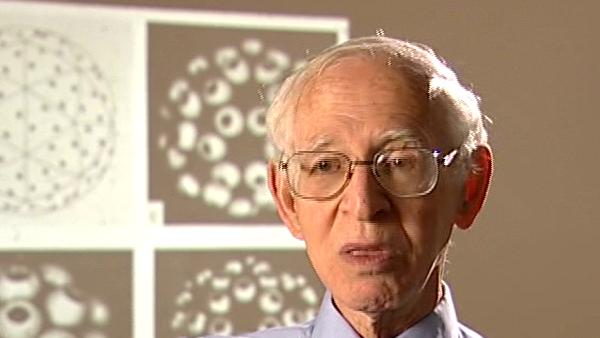NEXT STORY

Gene conversion and gene targeting
RELATED STORIES

NEXT STORY

Gene conversion and gene targeting
RELATED STORIES



Gene correction... It's replacing a mutant gene in a monogenic disease by correct copy of the gene. Now this is not gene... this is not adding a correct copy as a lot of gene therapy has been, and as a background, and I'll tell you about the French trial for SCID. SCID is Severe Combined Immunodeficiency Disease. It's the disease in which children are born without an immune system and the reason is that they have mutation in the IL receptor, IL is the interleukin, IL receptor gamma-gene which is found in the precursors in the development of the immune system. So children born without an immune system and then susceptible to disease, so they had to be brought up as babies, they had to be brought up in a bubble, they're called 'bubble babies', you must have read about them?
[Q] Yes.
And now there are not so many, numbers are tens of thousands rather than hundreds of thousands, but I think there's 80,000 in the States, I don't know what the numbers are in Europe. So there's a trial which had some success, was conducted in Paris by a man called Alain Fisher and what he did was to make a correct copy of the SCID gene, put it into a retrovirus and carried this into the cell. Integrated into the cell. There were ten children originally and that was three years ago, three or more years ago now. And eight of those children are still living, two died, they died of leukaemia. One of the still living ones has got leukaemia, so what went wrong? You see, it was met with great acclaim. Now this is gene addition. You're adding a good copy of the gene which can be read and transcribed but doing it this way you have no control where the gene goes into, it goes into the chromosome. Also, you have a vector which gets separated from the gene when the gene... from the correct... which is inserted. So the effect was diagnosed, the two children who died had the vector managed to lodge itself in front of a well-known cancer gene, called the Lmo2, and this produced cancer in the children, leukaemia. So that's gene addition. Now there could be ways of overcoming that if you could deliver the gene... deliver the correct gene to its right place and there might be a way of doing that with zinc fingers. I can think of several ways, but that's not been done yet. What has been done is to gene correction or gene editing and that's quite complicated without diagrams. It invokes the use of two natural systems, one is zinc fingers which I said 3% of the human genomes can target and we now know with synthetic engineered zinc fingers you can target a gene with single gene specificity. I didn't tell you this, but these things we make, or have made, if you use a DNA array of 20,000 genes only one out of 20,000 lights up. So it really is virtually single gene specificity. So... now that should have been in the preamble.
Born in Lithuania, Aaron Klug (1926-2018) was a British chemist and biophysicist. He was awarded the Nobel Prize in Chemistry in 1982 for developments in electron microscopy and his work on complexes of nucleic acids and proteins. He studied crystallography at the University of Cape Town before moving to England, completing his doctorate in 1953 at Trinity College, Cambridge. In 1981, he was awarded the Louisa Gross Horwitz Prize from Columbia University. His long and influential career led to a knighthood in 1988. He was also elected President of the Royal Society, and served there from 1995-2000.
Title: Gene editing: Severe Combined Immunodeficiency Disease
Listeners: Ken Holmes John Finch
Kenneth Holmes was born in London in 1934 and attended schools in Chiswick. He obtained his BA at St Johns College, Cambridge. He obtained his PhD at Birkbeck College, London working on the structure of tobacco mosaic virus with Rosalind Franklin and Aaron Klug. After a post-doc at Childrens' Hospital, Boston, where he started to work on muscle structure, he joined to the newly opened Laboratory of Molecular Biology in Cambridge where he stayed for six years. He worked with Aaron Klug on virus structure and with Hugh Huxley on muscle. He then moved to Heidelberg to open the Department of Biophysics at the Max Planck Institute for Medical Research where he remained as director until his retirement. During this time he completed the structure of tobacco mosaic virus and solved the structures of a number of protein molecules including the structure of the muscle protein actin and the actin filament. Recently he has worked on the molecular mechanism of muscle contraction. He also initiated the use of synchrotron radiation as a source for X-ray diffraction and founded the EMBL outstation at DESY Hamburg. He was elected to the Royal Society in 1981 and is a member of a number of scientific academies.
John Finch is a retired member of staff of the Medical Research Council Laboratory of Molecular Biology in Cambridge, UK. He began research as a PhD student of Rosalind Franklin's at Birkbeck College, London in 1955 studying the structure of small viruses by x-ray diffraction. He came to Cambridge as part of Aaron Klug's team in 1962 and has continued with the structural study of viruses and other nucleoproteins such as chromatin, using both x-rays and electron microscopy.
Tags: Alain Fisher
Duration: 3 minutes, 44 seconds
Date story recorded: July 2005
Date story went live: 24 January 2008